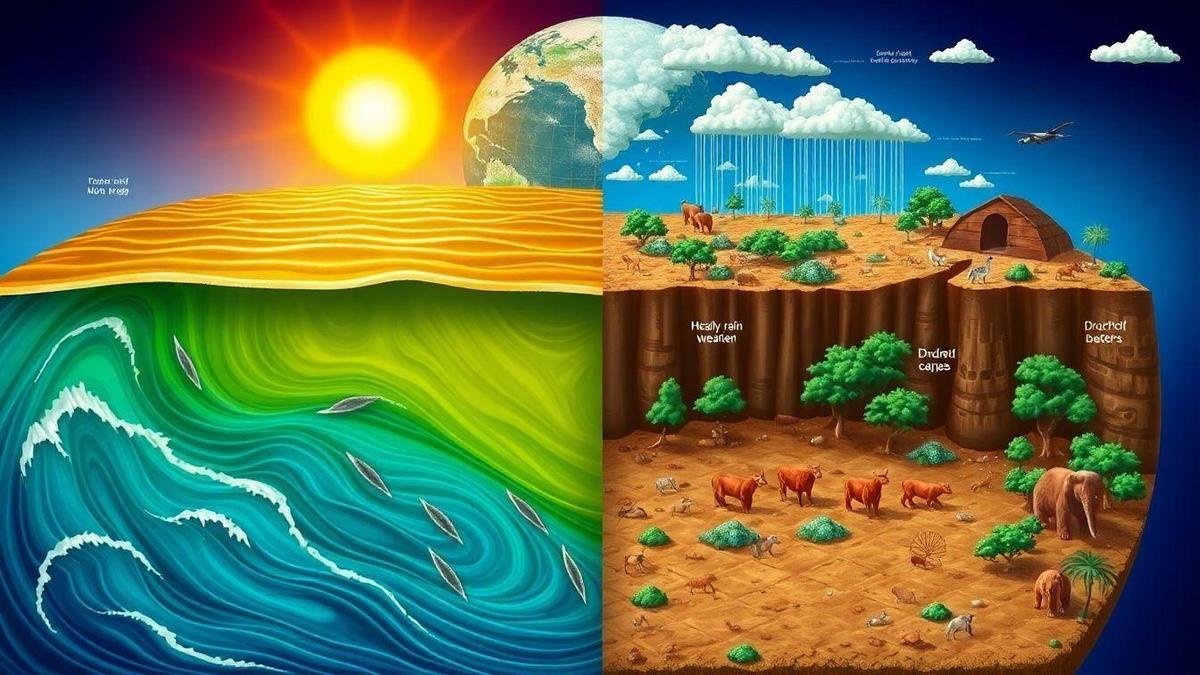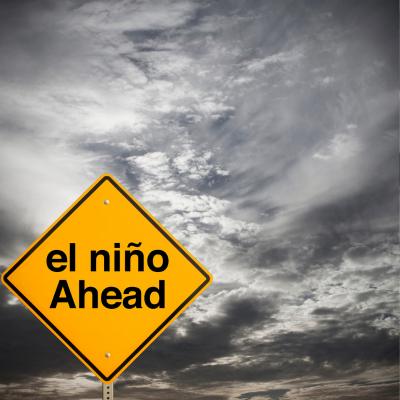Anúncios
The El Niño phenomenon is a periodic climatic disturbance that influences ecosystems and societies globally. It affects temperature patterns, precipitation, and atmospheric circulation. Its impact can be felt in various sectors such as agriculture, fishing, and water supply.
Understanding El Niño is vital for predicting and mitigating natural disasters. Analyzing its effects helps develop adaptation strategies. Thus, societies become more resilient in the face of climate changes intensified by this phenomenon.
Anúncios

Influence of El Niño on Global Climate Patterns
During El Niño events, there are significant changes in trade winds and ocean temperatures. These changes affect climate systems on a global scale, generating atmospheric instability. This results in unusual rain and drought patterns.
Tropical regions may face heavy rainfall, while traditionally wet areas suffer from droughts. This redistribution of moisture directly affects human and natural life. Floods and forest fires become more frequent.
Coastal zones in the Pacific, especially in South America, face severe climatic challenges. Torrential rains and landslides become recurrent during strong El Niño events. Such events affect infrastructure and cause significant economic losses.
Countries far from the Pacific are also affected, such as those in Africa and Southeast Asia. El Niño can alter monsoons and weaken important seasonal rains. This affects agricultural production and compromises food security.
Consequences for Marine Ecosystems
The warming of ocean waters drastically changes marine habitats. Species sensitive to temperature, such as corals and pelagic fish, are directly impacted. Coral bleaching becomes more frequent and threatening.
The availability of nutrients in coastal waters decreases with changes in currents. This affects phytoplankton, the base of the marine food chain. The scarcity of food can reduce fish and seabird populations.
As a result, fishing activities face significant losses during El Niño events. Regions economically dependent on fishing suffer social and economic impacts. The scarcity of fish compromises both trade and food security.
Migratory organisms change their routes or temporarily disappear. Dolphins, whales, and birds alter their migration patterns. This demonstrates the depth of the changes caused by the phenomenon in the marine balance.
Impact on Agriculture and Food Production
El Niño’s climatic impacts directly harm agriculture. Intense rains can flood crops, while prolonged droughts hinder crop growth. This leads to crop losses and food insecurity.
Developing countries, with greater dependence on agriculture, suffer more. The lack of irrigation and storage infrastructure exacerbates the effects. Small farmers are the most economically vulnerable.
The phenomenon can also interfere with agricultural cycles. Crops that depend on regular seasons are compromised. Crop productivity is significantly reduced.
Adaptations such as drought-resistant crops or smart irrigation systems are essential. Anticipating El Niño’s effects can mitigate losses. Public policies should include strategies for agricultural climate resilience.
Effects on Terrestrial Biodiversity

Changes in climate directly affect terrestrial fauna and flora. Species adapted to certain conditions may not survive sudden changes. This leads to displacements, local extinctions, and loss of biodiversity.
Extreme droughts reduce the availability of water and food. Terrestrial animals migrate in search of better conditions, altering ecosystems. Native plants may disappear, making room for invasive species.
Temperature changes also affect the reproductive cycles of many species. Animals and plants may suffer from mismatches between reproduction and resource availability. This compromises local ecological balance.
Protected areas and national parks also suffer the effects of El Niño. Conservation becomes more difficult during periods of climate stress. Investments in monitoring and mitigation are essential.
How the El Niño Phenomenon Affects Global Ecosystem Impacts
The El Niño phenomenon is a complex climatic event that originates in the Pacific Ocean, characterized by the periodic warming of sea surface temperatures. This phenomenon plays a critical role in influencing global climate patterns, leading to significant changes that can impact ecosystems worldwide. The effects of El Niño are not limited to regions adjacent to the Pacific Ocean; they have far-reaching consequences that can alter precipitation patterns, destabilize food chains, and impact biodiversity.
During an El Niño event, trade winds often weaken, allowing warm waters to accumulate in the eastern Pacific. This temperature change can lead to increased precipitation in some areas while causing droughts in others. The resulting climate changes can have profound effects on agriculture, water supply, and natural habitats. Understanding the mechanisms behind El Niño and its global impacts is essential for scientists, policymakers, and affected communities.
Benefits of Understanding the El Niño Phenomenon and Its Global Ecosystem Impacts
Understanding the El Niño phenomenon is crucial for several reasons. First, it allows for better prediction of climate patterns. By recognizing the signs of an impending El Niño event, meteorologists can provide early warnings to communities, allowing them to prepare for extreme weather conditions. This predictive capability can be vital for mitigating the impacts of natural disasters such as floods and droughts, which can devastate communities and economies.
Second, understanding El Niño can help manage agricultural practices. Farmers can adjust their planting schedules and crop choices based on the anticipated climate changes associated with El Niño. This proactive approach can lead to better harvests and reduced losses, ensuring food security in regions particularly vulnerable to climate variability.
Third, awareness of El Niño’s effects on marine ecosystems can inform sustainable fishing practices. Changes in temperatures and ocean currents can impact fish populations and their habitats. By understanding these dynamics, fisheries can adapt their practices to promote sustainability and avoid overfishing, ensuring the long-term health of marine resources.
Finally, understanding El Niño contributes to the broader field of climate science. It provides insights into the interconnectedness of global climate systems and the potential impacts of climate change. As we continue to face the challenges of a changing climate, knowledge of phenomena like El Niño will be essential for developing effective adaptation and mitigation strategies.
How to Recognize and Respond to the El Niño Phenomenon and Its Global Ecosystem Impacts

Recognizing the El Niño phenomenon requires careful monitoring of various environmental indicators. One of the key signs is the increase in ocean temperatures in the central and eastern Pacific. This warming can be tracked through satellite observations and ocean buoys, providing valuable data for scientists and meteorologists.
In addition to temperature changes, alterations in climate patterns can serve as indicators of an impending El Niño event. For example, regions that typically experience dry conditions may see an increase in precipitation, while areas that are usually wet may experience droughts. Observing these changes is crucial for timely responses.
Changes in biodiversity in local ecosystems may also signal the onset of El Niño. As temperature and precipitation patterns change, species may migrate or alter their behavior in response to new environmental conditions. Tracking these changes can help conservationists understand the impacts of El Niño on wildlife and local ecosystems.
Agricultural productivity is another area that may be affected by El Niño. Farmers can assess potential crop losses by monitoring weather forecasts and historical data related to El Niño events. This information can guide decisions on crop management and resource allocation.
Sustainability issues in fisheries are also closely tied to the El Niño phenomenon. Changes in ocean temperatures can affect fish populations and their distribution. Monitoring these changes is essential to maintaining sustainable fishing practices and protecting marine ecosystems.
Preparing for extreme weather events is critical in regions prone to El Niño impacts. Communities can develop contingency plans and invest in infrastructure to mitigate the effects of floods, droughts, and other climate-related challenges.
In conclusion, recognizing and responding to the El Niño phenomenon involves a multifaceted approach that includes monitoring ocean temperatures, observing changes in climate patterns, tracking biodiversity shifts, assessing agricultural productivity, evaluating fishing sustainability, and preparing for extreme weather events.
Did You Enjoy Learning About the El Niño Phenomenon and Its Global Ecosystem Impacts?
Learning about the El Niño phenomenon and its impacts on the global ecosystem opens up a world of understanding about climate dynamics. The interconnectedness of climate patterns and ecosystems highlights the importance of scientific research and community engagement in addressing climate-related challenges. By staying informed and proactive, we can better navigate the complexities of our changing environment.
As we continue to explore the implications of the El Niño phenomenon, it becomes clear that knowledge is a powerful tool in our efforts to adapt and thrive in a world influenced by climate variability. Engaging with this topic not only enhances our understanding but also empowers us to act in our communities and beyond.
Frequently Asked Questions
What is the El Niño phenomenon?
El Niño is an abnormal warming of the Pacific Ocean waters. This occurs every few years.
How does the El Niño phenomenon affect the climate?
It can cause changes in rainfall and temperature patterns. In some regions, it brings droughts, while in others, heavy rain.
What are the impacts of El Niño on global ecosystems?
The El Niño phenomenon and its global impacts can destabilize habitats. Fish and birds may suffer from these changes.
Can El Niño affect agriculture?
Yes! El Niño can harm crops. Crops may be destroyed by droughts or heavy rains.
How can we prepare for the effects of El Niño?
Stay alert to weather forecasts. This helps you prepare for the changes that may come.
